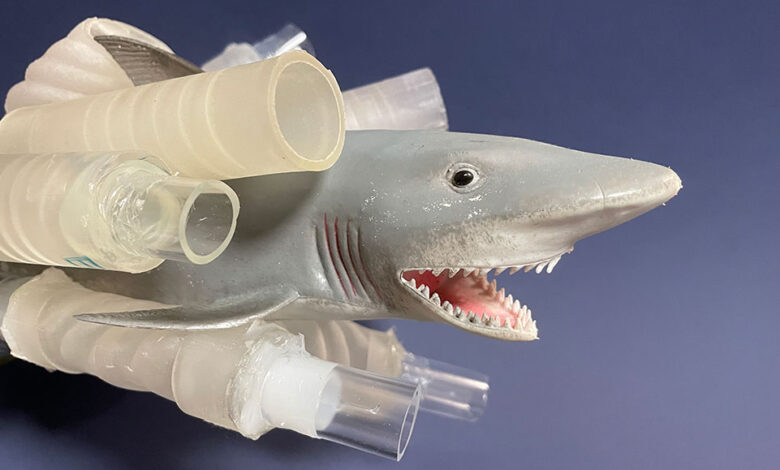Shark intestines inspire pipes with a strictly one-way flow


3-D printing: A means of producing physical items — including toys, foods and even body parts — using a machine that takes instructions from a computer program. That program tells the machine how and where to lay down successive layers of some raw material (the “ink”) to create a three-dimensional object.
angle: The space (usually measured in degrees) between two intersecting lines or surfaces at or close to the point where they meet.
coil: Concentric rings or spirals formed by winding wire or some other fiber around and around a core; or the shape that such a wire would make.
colleague: Someone who works with another; a co-worker or team member.
contaminant: Pollutant; a chemical, biological or other substance that is unwanted or unnatural in an environment (such as water, soil, air, the body or food). Some contaminants may be harmful in the amounts at which they occur or if they are allowed to build up in the body or environment over time.
current: A fluid — such as of water or air — that moves in a recognizable direction.
engineering: The field of research that uses math and science to solve practical problems. Someone who works in this field is known as an engineer.
fluid mechanics: The study of the properties of fluids (liquids and gases) and their reactions to the forces acting upon them under various conditions.
gut: An informal term for the gastrointestinal tract, especially the intestines.
helix: An object with a three-dimensional shape like that of a wire wound uniformly in a single layer around a cylinder or cone, as in a corkscrew or spiral staircase.
mechanics: The study of how things move.
perpendicular: An adjective that describes two things that are situated approximately 90 degrees to each other. In the letter “T,” the top line of the letter is perpendicular to the bottom line.
physicist: A scientist who studies the nature and properties of matter and energy.
Proceedings of the National Academy of Sciences: A prestigious journal publishing original scientific research, begun in 1914. The journal’s content spans the biological, physical and social sciences. Each of the more than 3,000 papers it publishes each year, now, are not only peer reviewed but also approved by a member of the U.S. National Academy of Sciences.
resin: A sticky, sometimes aromatic substance, often secreted by plants. It may also be the viscous starting ingredient for some plastics that will harden when heated or treated with light.
shark: A type of predatory fish that has survived in one form or another for hundreds of millions of years. Cartilage, not bone, gives its body structure. Like skates and rays, sharks belong to a group known as elasmobranchs. They tend to grow and mature slowly and have few young. Some lay eggs, others give birth to live young.
system: A network of parts that together work to achieve some function. For instance, the blood, vessels and heart are primary components of the human body’s circulatory system. Similarly, trains, platforms, tracks, roadway signals and overpasses are among the potential components of a nation’s railway system. System can even be applied to the processes or ideas that are part of some method or ordered set of procedures for getting a task done.
valve: Something that can reduce or shut off the flow of some gas or liquid through a pipe or other passageway. Some specialized valves may allow a liquid or gas to flow in one direction only.



